This lesson is duplicated in an Order of the Divine Mother lesson so if you have already completed it, you do not have to do it again.
Mary As Bride, Study Guide 1, by Initiate Saules Meita (aka Dace Liepins)
This study guide has been created using variety of sources, primarily using text and writings from The White Moon, a page created by Luna Blanca (aka Dr. Cynthia Lynnville )
Bride- The word bride is derived from Germanic language –it stood for new wife.
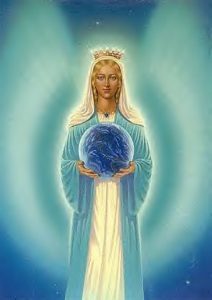 The Bride of Christ
The Bride of Christ
In recent religious writings, the Roman Catholic Church has named The Blessed Virgin Mary as the Bride of Christ. The Orthodox Church also sees Mary as the Bride of Christ.
In light of the knowledge that ancient goddesses often had a Mother/Lover relationship to their Divine Sons, perhaps the notion of Mary as both Mother & Bride of Christ shouldn’t seem strange. But Christianity diverges from the Old Religions most sharply in its denial of sexuality. Isn’t it extraordinary, then, that Mary, celebrated for her lack of sexuality, has come to claim the title of Bride, just as the ancient goddesses did?
The Esoteric Mystery School as well as other religious organizations believe that Jesus was married to and fathered a child with the Magdalene, his earthly bride. Evidence suggests that The Song of Songs celebrated Mary Magdalene in early Christianity, not Mother Mary. But after worship of the Magdalene was suppressed, all devotions to her were officially transferred to Mother Mary. This is one theory.
Another theory suggests that the ancient definition of Virgin was retained in cultural consciousness. An ancient virgin was not celibate, only autonomous, and thus many of the ancient love goddesses were also hailed “Virgin.”
Added to this is the Spiritual archetype of Marriage, an archetype which reflects a union of separate parts (separate selves) into a whole, a union of Self with The Divine. It is this definition of Spiritual Marriage that the orthodox Church claims in endowing Mary with the title “Bride of Christ.”
However, Mary was viewed as a real-life bride too, the bride of Joseph, as the painting “Marriage of the Virgin” affirms (see below). Perhaps more than any other factor, it was the need for real-life spiritual models that molded Mary into a Bride.
Regardless of the reasons, in 370 Ambrose officially identified Mary as the Bride in The Song of Songs, linking her with Paul’s symbol of The Christian Church as Bride (A, B). The title “Bride of Christ” was soon extended to nuns and to each Christian’s soul (B). Thus, both Christ and Mary became Spiritual Lover.
The Exoteric Church is also seen as the Bride of Christ, awaiting his return.
Please copy the questions below into a new email, insert your answers, then send to Mystery School with “Templar, Mary Bride 1” in the subject line.
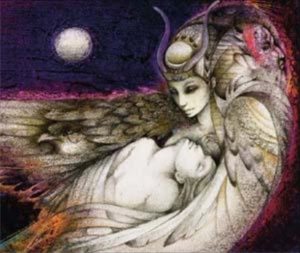 Part 1: Questions for The Bride of Christ segment:
Part 1: Questions for The Bride of Christ segment:
1. What are your thoughts and feelings about Mary and the Church both being Brides of Christ?
2. What are the two definitions of “virgin?”
3. In earlier lessons, a comparison was made between Isis and Osiris and Mary and Yeshua. Please explore The Encyclopedia Mythica to find other examples of God and Goddess as both Spouses and Siblings.
4. How do these examples parallel the idea of Mary and Yeshua as spouses?
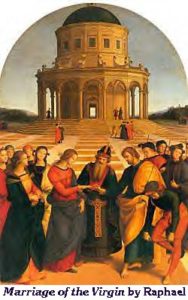 The Bride of God
The Bride of God
Hosea, Jeremiah, Ezekiel, and Isaiah all describe Israel, The Chosen People, as The Bride of Yahweh/Jehovah. These prophets paint God as Divine Husband, at times angry and jealous, at times loving and joyous (B). The Israelites were surrounded with images of a Divine Husband and Wife from the “heathen” cultures around them. The Goddess “Asherah (sometimes called Ashtoreth, Astarte, or Anat) and her Divine Consort, Baal, appear multiple times throughout the Old Testament as the Israelite prophets seek to eradicate their influence — not very successfully, judging from their own accounts.
Strong archeological evidence suggests that the Israelites incorporated Asherah into Judaism, worshiping her as Wife of Yahweh. In fact, the Biblical record shows that Solomon encouraged worship of Asherah in the Jerusalem temple:
The king defiled the high places . . . which Solomon, king of Israel, had built in honor of Astarte . . . Then the king commanded the high priest . . . to remove from the temple of the Lord all the objects that had been made for Baal, Asherah, and the whole host of heaven . . . . From the temple of the Lord he also removed the sacred pole [a symbol of Asherah] . . . . and tore down the apartments . . . which were in the temple of the Lord and in which the women wove garments for the Asherah.
II Kings 23:13; 4-7
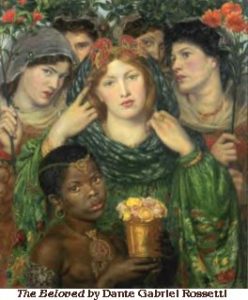 Daughter Zion: God’s Bride in the Old Testament
Daughter Zion: God’s Bride in the Old Testament
The Old Testament prophets often compared the Mosaic Covenant to a “marriage covenant” between God and Israel. They portrayed God as the Bridegroom/Husband in this covenant, and Israel as His beloved bride. Though this imagery often occurs in a negative light, in which the Israelites’ dabbling in paganism is portrayed as “adultery” against God the Bridegroom, much tenderness and love also comes through in some passages.
In Jeremiah 2:2-3, God recalls Israel’s original love for him during the Exodus:
I remember the devotion of your youth, your love as a bride, how you followed me in the wilderness, in a land not sown.
Israel was holy to the Lord, the first fruits of his harvest.
In Hosea, the Lord compares Israel’s impending captivity to that original desert experience, and portrays it as a new beginning for Him and His Bride:
Behold, I will allure her,
and will lead her into the wilderness
and will speak to her heart…
and she shall sing there as in the days of her youth
as in the days of her coming up out of the land of Egypt.
And on than day, says the Lord,
she shall call me “my husband”
and no more “my lord” (Baal)…
I will betroth you to me forever,
I will betroth you in righteousness,
in justice, in loving kindness and in compassion.
I will betroth you to me in faith,
and you shall know that I am the Lord.
– Hosea 2:14-16; 19-20
Though Bride Israel had strayed from Him, God promises to accept her back:
For the Lord has called you as a woman forsaken and mournful in spirit,
and as a wife cast off from her youth, says your God.
For a short time I forsook you, but with great mercy I will gather you
In a moment of anger I hid my face from you
but with everlasting love I will have mercy on you
says the Lord your Redeemer. – Isaiah 54:6-7
In Ezekiel, God compares Bride Israel to a young woman, using some striking sexual imagery to describe his love for her:
Then you grew up, became tall, and reached the age for fine ornaments; your breasts were formed and your hair had grown.Yet you were naked and bare.Then I passed by you and saw that you were ready for love; so I spread My cloak over you and covered your nakedness. I swore to you and entered into a covenant with you so that you became mine, declares the Lord God. – Ezekiel 16:7-8
The phrase “spread my cloak over you” was a Hebrew euphemism for intercourse (see Ruth 3:9). Such intimate language should give us an idea of the goodness of marital relations.
Israel-as-God’s beloved soon became clearly personified in the figure of Daughter Zion. As Tikva Frymer-Kensey comments,
The name “Zion” is never used in angry passages: it always stands for the beloved…Jeremiah uses the name “Jerusalem” in anger, rebuking her for persistent rebellion,and for conduct deserving of punishment. But he uses the name “Zion” in love, sorrow, and hope rather than anger.
Originally the name of a section of Jerusalem, “the Daughter of Zion” (Bat Zion) soon became the hypostatized “spirit” of the city and the nation: “Zion is not simply the stones of the houses, but a mystical person, the essence of the city, who can separate herself from the physical confines of the city walls” 4.Unlike Jerusalem the adulteress, Zion was the idealized wife of the Lord.
Rabbis would eventually interpret the Song of Songs, a Scriptural love song, as an allegory of God’s love for Israel/Zion.They identified the “Shulamite”, the woman in the Song of Songs, with Israel, and her lover with the Lord. This allegorical interpretation made it easier to accept the book into the canon of Scripture.
Mary as Daughter Zion and Mother Church
As the Jewish maiden chosen to bear the promised Messiah, Mary embodies Bat Zion. Scholars believe that the words of Saint Gabriel the Archangel to Mary at the Annunciation reflect Zephaniah’s words to Daughter Zion. She is thus the personification of God’s faithful bride. One of Mary’s titles among Ethiopian Christians is Saint Mary of Zion. This emphasizes both her Jewish ancestry and her identification with Daughter Zion.
Medieval Christians began to identify the Shulamite of the Song of Songs with Mary. (Godfrey of Admont was one significant example of this.) Many writers believed that Sgs 4:7 signified the Immaculate Conception: “Thou art all fair, my love, and there is no spot in thee”. This verse became the origin of the Catholic prayer: Thou art all fair, O Mary, and the original stain is not found in thee.
The Legion of Mary uses Sgs 6:9 as the antiphon for the Catena Legionis: “Who is she that cometh forth as the morning rising, fair as the moon, bright as the sun, terrible as an army set in battle array?”
The Woman of Apocalypse (Revelation) is an image combining all three of these feminine persons: Daughter Zion (vvs 1-2), Mary the Mother of the Messiah (vs 5 – see Luke 2:7) and the persecuted Church (vvs 13-17). The obvious parallel between this passage and Genesis 3:15 identifies this glorious Woman as the New Eve. As we shall see, early Christians perceived both Mary and the Church as the New Eve…
…Gazing on her Divine Bridegroom, rapt in joyful ecstasy, Mary enjoys the unitive bliss of which a physical climax is only a hint and foreshadowing. Her passionate love for God is reflected in the eyes of every earthly bride as she gazes on her new husband on their wedding night. Her perpetual virginity does not leave her cold and loveless, for she is consumed with a Divine Love that is stronger than death, with a passion relentless as the grave, whose “flames are a blazing fire, the very flame of the Lord” (Song of Songs 8:6).
Excerpted from http://home.nyc.rr.com/mysticalrose/bride.html
Please copy the questions below into a new email, insert your answers, then send to Mystery School with “Templar, Mary Bride 2” in the subject line.
Part 2: Questions for The Bride of God OT segment:
1. How does Mary personify the Daughter of Zion refered to in the Old Testament?
2. With Mary seen as both the Mother of God and the Bride of God what does this say for us as Children of God?
3. What are your thoughts on the idea of “physical climax” being a foreshadowing of the Bliss of Heaven?
4. In the painting “The Beloved” above, Rossetti used as his inspiration verses from Song of Solomon and Psalm 45: My beloved is mine and I am his. (The Song of Solomon 2:16). Let him kiss me with the kisses of his mouth: for thy love is better than wine. (The Song of Solomon 1:2). She shall be brought unto the King in raiment of needlework: the virgins her companions that follow her shall be brought unto thee. (Psalms 45:14) What symbols and colors did Rossetti use to reflect the Song of Solomon? (for more information about the painting, see http://www.tate.org.uk/
The Bride of the Holy Spirit
Novena Prayer to Our Lady of Good Remedy
O QUEEN OF HEAVEN and earth, Most Holy Virgin, we venerate thee. Thou art the beloved Daughter of the Most High God, the chosen Mother of the Incarnate Word, the Immaculate Spouse of the Holy Spirit, the Sacred Vessel of the Most Holy Trinity. O Mother of the Divine Redeemer, who under the title of Our Lady of Good Remedy comes to the aid of all who call upon thee, extend thy maternal protection to us. We depend on thee, Dear Mother, as helpless and needy children depend on a tender and caring mother.
The Novena Prayer above names Mary as the Spouse of the Holy Spirit. This designation appears not infrequently in the writings of the Roman Catholic Church. Pope John Paul II names her as the most perfect embodiment of Bride and Virgin.
The following is an excerpt from the apostolic letter “Mulieris Dignitatem” by Pope John Paul II. This letter discusses “dignity and vocation of women.”
” We must now focus our meditation on virginity and motherhood as two particular dimensions of the fulfillment of the female personality. In the light of the Gospel, they acquire their full meaning and value in Mary, who as a Virgin became the Mother of the Son of God. These two dimensions of the female vocation were united in her in an exceptional manner, in such a way that one did not exclude the other but wonderfully complemented it. The description of the Annunciation in the Gospel of Luke clearly shows that this seemed impossible to the Virgin of Nazareth. When she hears the words: “You will conceive in your womb and bear a son, and you shall call his name Jesus,” she immediately asks: “How can this be, since I have no husband?” (Lk 1:31, 34) In the usual order of things motherhood is the result of mutual “knowledge” between a man and woman in the marriage union. Mary, firm in her resolve to preserve her virginity, -puts this question to the divine messenger, and obtains from him the explanation: “The Holy Spirit will come upon you”– your motherhood will not be the consequence of matrimonial “knowledge,” but will be the work of the Holy Spirit; the “power of the Most High” will “overshadow” the mystery of the Son’s conception and birth; as the Son of the Most High, he is given to you exclusively by God, in a manner known to God. Mary, therefore, maintained her virginal “I have no husband” (cf. Lk 1:34) and at the same time became a Mother. Virginity and motherhood co-exist in her: they do not mutually exclude each other or place limits on each other. Indeed, the person of the mother of God helps everyone–especially women–to see how these two dimensions, these two paths in the vocation of women as persons, explain and complete each other… “
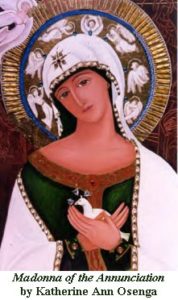 The Madonna of the Annunciation depicts the moment after the announcement by Gabriel. The Holy Spirit is with the Madonna, resting in her open hands, and the angel is departing from the left hand corner.
The Madonna of the Annunciation depicts the moment after the announcement by Gabriel. The Holy Spirit is with the Madonna, resting in her open hands, and the angel is departing from the left hand corner.
The white of the Madonna’s veil, draping across her head and shoulders, signifies her purity, and the green of her tunic, the life now within her. The golden halo and its contents tells of the Madonna’s identity: the seven angels represent the gifts of the Holy Spirit that have been with her since her conception, and the word Theotokos tells of the honor which is now hers.
The letter continues:
“…Spousal love–with its maternal potential hidden in the heart of the woman as a virginal bride–when joined to Christ, the Redeemer of each and every person, is also predisposed to being open to each and every person. This is confirmed in the religious communities of apostolic life, and in a different way in communities of contemplative life, or the cloister. There exist still other forms of a vocation to virginity for the sake of the Kingdom; for example, the Secular Institutes, or the communities of consecrated persons which flourish within movements, groups and associations. In all of these the same truth about the spiritual motherhood of virgins is confirmed in various ways. However, it is not only a matter of communal forms but also of non-communal forms. In brief, virginity as a woman’s vocation is always the vocation of a person–of a unique, individual person. Therefore the spiritual motherhood which makes itself felt in this vocation is also profoundly personal.
This is also the basis of a specific convergence between the virginity of the unmarried woman and the motherhood of the married woman. This convergence moves not only from motherhood towards virginity, as emphasized above; it also moves from virginity towards marriage, the form of woman’s vocation in which she becomes a mother by giving birth to her children. The starting point of this second analogy is the meaning of marriage. A woman is “married” either through the sacrament of marriage or spiritually through marriage to Christ. In both cases marriage signifies the “sincere gift of the person” of the bride to the groom. In this way, one can say that the profile of marriage is found spiritually in virginity. And does not physical motherhood also have to be a spiritual motherhood, in order to respond to the whole truth about the human being who is a unity of body and spirit? Thus there exist many reasons for discerning in these two different paths–the two different vocations of women–a profound complementarity, and even a profound union within a person’s being.”
The entire text of this document may be found at
http://www.ewtn.com/library/PAPALDOC/JP2MULIE.HTM
Part 3: Questions for The Bride of the Holy Spirit / God NT segment:
Please copy the questions below into a new email, insert your answers, then send to Mystery School with “Templar, Mary Bride 3” in the subject line.
1. John Paul II states that the two primary vocations of woman are virginity and marriage. How is this reflected in the exoteric Church?
2. What is your interpretation of Mary “firm in her resolve to preserve her virginity?”
3. As Children of the Divine, how are we, too, spouses of the Holy Spirit?
4. Compare and contrast “physical motherhood” and “spiritual motherhood”
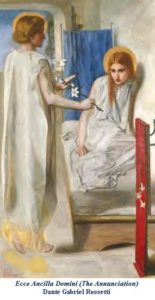
Inspired by the work of early Renaissance artists such as Botticelli (1445-1510) and Fra Angelico (1387-1455), Rossetti sought in this work a radical reinterpretation of the Annunciation. Traditionally the Virgin was depicted in studious contemplation, reading a missal at a prie-dieu; but here Rossetti shows her rising awkwardly from a low bed, as if disturbed from sleep, while the Angel Gabriel presents her with a white lily. Both figures are dressed in white, a symbol of the virgin’s purity, and the angel’s role as the messenger of god is emphasized by the small white dove hovering beside him, signifying the presence of the holy spirit. Contemporary critics howled with outrage at the picture, denouncing it as an example of the perversion of talent which has recently been making so much headway.
5. When you look at the figures in the picture, what emotions are the characters feeling?
6. Why do you think Rossetti portrayed them that way?
7. Why would this work, finished in 1850, make critics of the time “howl in outrage”?
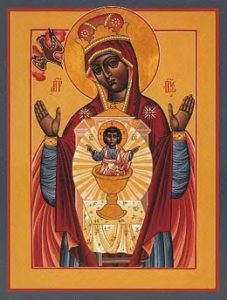
We fly to your patronage, O holy Birthgiver of God;
despise not our petition in our necessities,
but deliver us always from all dangers,
O ever-glorious and blessed Virgin.
-The oldest known prayer to Mary.

